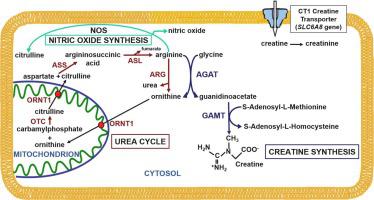Molecular Genetics and Metabolism Reports ( IF 1.8 ) Pub Date : 2021-08-23 , DOI: 10.1016/j.ymgmr.2021.100791 Filippo Ingoglia 1, 2 , Jean-Leon Chong 1, 2 , Marzia Pasquali 1, 2, 3 , Nicola Longo 1, 2, 3

|
The urea cycle generates arginine that is one of the major precursors for creatine biosynthesis. Here we evaluate levels of creatine and guanidinoacetate (the precursor in the synthesis of creatine) in plasma samples (ns = 207) of patients (np = 73) with different types of urea cycle disorders (ornithine transcarbamylase deficiency (ns = 22; np = 7), citrullinemia type 1 (ns = 60; np = 22), argininosuccinic aciduria (ns = 81; np = 31), arginase deficiency (ns = 44; np = 13)). The concentration of plasma guanidinoacetate positively correlated (p < 0.001, R2 = 0.64) with levels of arginine, but not with glycine in all patients with urea cycle defects, rising to levels above normal in most samples (34 out of 44) of patients with arginase deficiency. In contrast to patients with guanidinoacetate methyltransferase deficiency (a disorder of creatine synthesis characterized by elevated guanidinoacetate concentrations), creatine levels were normal (32 out of 44) or above normal (12 out of 44) in samples from patients with arginase deficiency. Creatine levels correlated significantly, but poorly (p < 0.01, R2 = 0.1) with guanidinoacetate levels and, despite being overall in the normal range in patients with all other urea cycle disorders, were occasionally below normal in some patients with argininosuccinic acid synthase and lyase deficiency. Creatine levels positively correlated with levels of methionine (p < 0.001, R2 = 0.16), the donor of the methyl group for creatine synthesis. The direct correlation of arginine levels with guanidinoacetate in patients with urea cycle disorders explains the increased concentration of guanidino compounds in arginase deficiency. Low creatine levels in some patients with other urea cycle defects might be explained by low protein intake (creatine is naturally present in meat) and relative or absolute intracellular arginine deficiency.
中文翻译:

尿素循环障碍患者的肌酸代谢
尿素循环产生精氨酸,它是肌酸生物合成的主要前体之一。在这里,我们评价血浆样品中的肌酸和guanidinoacetate(肌酸的合成前体)(n个水平小号 的病人= 207)(N p 与不同类型的尿素循环障碍的= 73)(鸟氨酸酶缺乏症(N小号 = 22 ;n p = 7),1 型瓜氨酸血症(n s = 60;n p = 22),精氨琥珀酸尿症(n s = 81;n p = 31),精氨酸酶缺乏症(n s = 44;n p = 13)) . 血浆胍基乙酸盐浓度呈正相关(p < 0.001,R2 = 0.64) 精氨酸水平,但不是所有尿素循环缺陷患者的甘氨酸,在精氨酸酶缺乏症患者的大多数样本(44 个中的 34 个)中升高到高于正常水平。与胍基乙酸甲基转移酶缺乏症(一种以胍基乙酸盐浓度升高为特征的肌酸合成障碍)患者相比,精氨酸酶缺乏症患者的样本中肌酸水平正常(44 人中有 32 人)或高于正常水平(44 人中有 12 人)。肌酸水平显着相关,但很差(p < 0.01,R 2 = 0.1) 胍基乙酸盐水平,尽管在所有其他尿素循环障碍患者中总体上处于正常范围内,但在一些精氨琥珀酸合酶和裂解酶缺乏症患者中偶尔低于正常值。肌酸水平与甲硫氨酸(p < 0.001,R 2 = 0.16)水平呈正相关,甲硫氨酸是肌酸合成的甲基供体。尿素循环障碍患者精氨酸水平与胍基乙酸盐的直接相关性解释了精氨酸酶缺乏症中胍基化合物浓度增加的原因。一些具有其他尿素循环缺陷的患者的肌酸水平低可能是由于蛋白质摄入量低(肌酸天然存在于肉类中)和相对或绝对细胞内精氨酸缺乏症。











































 京公网安备 11010802027423号
京公网安备 11010802027423号